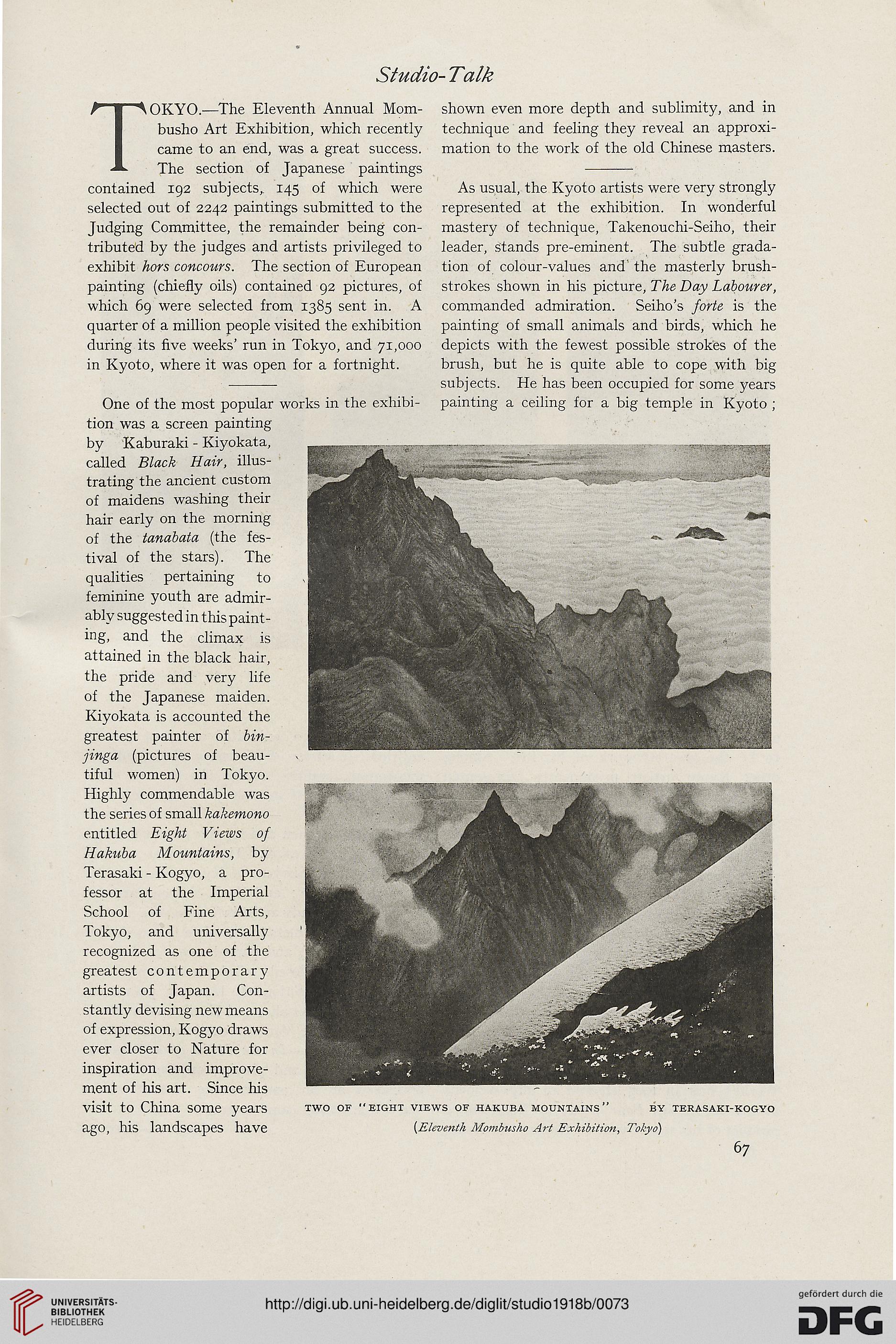Studio- Talk
T
OKYO.—The Eleventh Annual Mom- shown even more depth and sublimity, and in
busho Art Exhibition, which recently technique and feeling they reveal an approxi-
came to an end, was a great success, mation to the work of the old Chinese masters.
The section of Japanese paintings -
contained 192 subjects, 145 of which were As usual, the Kyoto artists were very strongly
selected out of 2242 paintings submitted to the represented at the exhibition. In wonderful
Judging Committee, the remainder being con- mastery of technique, Takenouchi-Seiho, their
tributed by the judges and artists privileged to leader, stands pre-eminent. The subtle grada-
exhibit hors concours. The section of European tion of colour-values and the masterly brush-
painting (chiefly oils) contained 92 pictures, of strokes shown in his picture, The Day Labourer,
which 69 were selected from 1385 sent in. A commanded admiration. Seiho's forte is the
quarter of a million people visited the exhibition painting of small animals and birds, which he
during its five weeks' run in Tokyo, and 71,000 depicts with the fewest possible strokes of the
in Kyoto, where it was open for a fortnight. brush, but he is quite able to cope with big
- subjects. He has been occupied for some years
One of the most popular works in the exhibi- painting a ceiling for a big temple in Kyoto ;
tion was a screen painting
by Kaburaki - Kiyokata,
called Black Hair, illus- ^ j^SHta,
trating the ancient custom
of maidens washing their
hair early on the morning
of the tanabata (the fes-
tival of the stars). The
qualities pertaining to
feminine youth are admir-
ably suggested in this paint-
ing, and the climax is
attained in the black hair,
the pride and very life
of the Japanese maiden.
Kiyokata is accounted the
greatest painter of bin-
jinga (pictures of beau-
tiful women) in Tokyo.
Highly commendable was
the series of small kakemono
entitled Eight Views of
Hakuba Mountains, by
Terasaki - Kogyo, a pro-
fessor at the Imperial
School of Fine Arts,
Tokyo, and universally
recognized as one of the
greatest contemporary
artists of Japan. Con-
stantly devising new means
of expression, Kogyo draws
ever closer to Nature for
inspiration and improve-
ment of his art. Since his
visit to China some years two of "eight views of hakuba mountains" by terasaki-kogyo
ago, his landscapes have {Eleventh Mqmbusho Art Exhibition, Tokyo)
67
T
OKYO.—The Eleventh Annual Mom- shown even more depth and sublimity, and in
busho Art Exhibition, which recently technique and feeling they reveal an approxi-
came to an end, was a great success, mation to the work of the old Chinese masters.
The section of Japanese paintings -
contained 192 subjects, 145 of which were As usual, the Kyoto artists were very strongly
selected out of 2242 paintings submitted to the represented at the exhibition. In wonderful
Judging Committee, the remainder being con- mastery of technique, Takenouchi-Seiho, their
tributed by the judges and artists privileged to leader, stands pre-eminent. The subtle grada-
exhibit hors concours. The section of European tion of colour-values and the masterly brush-
painting (chiefly oils) contained 92 pictures, of strokes shown in his picture, The Day Labourer,
which 69 were selected from 1385 sent in. A commanded admiration. Seiho's forte is the
quarter of a million people visited the exhibition painting of small animals and birds, which he
during its five weeks' run in Tokyo, and 71,000 depicts with the fewest possible strokes of the
in Kyoto, where it was open for a fortnight. brush, but he is quite able to cope with big
- subjects. He has been occupied for some years
One of the most popular works in the exhibi- painting a ceiling for a big temple in Kyoto ;
tion was a screen painting
by Kaburaki - Kiyokata,
called Black Hair, illus- ^ j^SHta,
trating the ancient custom
of maidens washing their
hair early on the morning
of the tanabata (the fes-
tival of the stars). The
qualities pertaining to
feminine youth are admir-
ably suggested in this paint-
ing, and the climax is
attained in the black hair,
the pride and very life
of the Japanese maiden.
Kiyokata is accounted the
greatest painter of bin-
jinga (pictures of beau-
tiful women) in Tokyo.
Highly commendable was
the series of small kakemono
entitled Eight Views of
Hakuba Mountains, by
Terasaki - Kogyo, a pro-
fessor at the Imperial
School of Fine Arts,
Tokyo, and universally
recognized as one of the
greatest contemporary
artists of Japan. Con-
stantly devising new means
of expression, Kogyo draws
ever closer to Nature for
inspiration and improve-
ment of his art. Since his
visit to China some years two of "eight views of hakuba mountains" by terasaki-kogyo
ago, his landscapes have {Eleventh Mqmbusho Art Exhibition, Tokyo)
67




